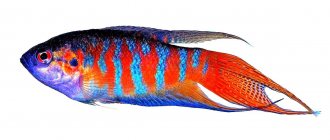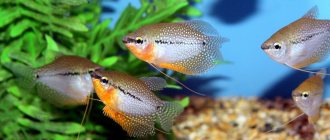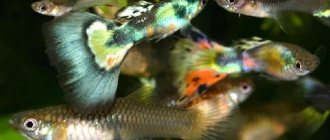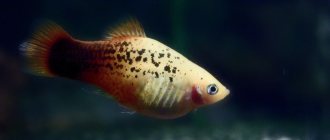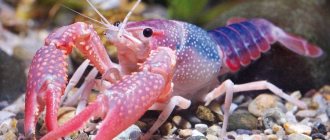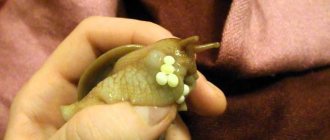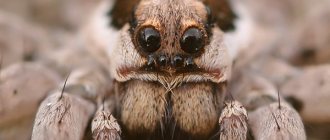Description
Valued for its unusual color, ability to reproduce in a community aquarium, and livability.
Appearance
The body is elliptical, elongated. Laterally compressed. The mouth is large, oriented upward. The color of the body and fins is velvety black. Aquarists consider the presence of light spots to be a defect.
The latest achievement of breeders is the tail fin of the black molly in the shape of a rotated letter “Ω”. The ends are pointed. There are varieties with the dorsal fin extended towards the tail.
Males grow up to 50–60 mm, females – up to 60–80 mm.
Lifestyle
They are mobile in all areas of the aquarium and playful. Males are especially active. In an overcrowded tank and when there is a shortage of females, they are aggressive towards their relatives and defend the territory. Keep at a rate of 2 females to 1 male.
The situation is similar with a lack of food. Only females show aggression.
In nature, they are schooling fish. In captivity, gregariousness is less pronounced.
Lifespan
The black molly fish lives 3–3.5 years.
Mollies Peten
The endemic Petén molly species lives in Guatemala's Lake Petén. In this golden-colored molly, it is not the female that is large, but the male, reaching 12 centimeters and having a black sword-shaped outgrowth on the caudal fin. The fins and body are decorated with mother-of-pearl dots; the back fin has a reddish edge. Breeders have developed a velvety black form of this mollies. They are kept in conditions similar to those of the mollies latipin.
In natural conditions, mollies feed on insect larvae, small crustaceans and algae growing on plants, stones, and snags. When kept in an aquarium, a similar diet or its replacement with appropriate artificial food is recommended, most of which are sold at AquaMegaMole. Finely chopped spinach and boiled fish are given as additives. Feeds containing carotene enhance color.
Video about mollies of different varieties
Content
Black mollies are considered an unpretentious fish, but they are more demanding than other types of platies in terms of living conditions. Sensitive to temperature conditions. Prefers hard, clean water. Air purging is desirable, filtration is required.
Provide a lighted swimming area in the center of the container. Place shelters in the form of plants or stones, snags, grottoes.
Don't keep molly alone. The ideal option is 1 male for 3 females. Reduces male hostility.
Aquarium size
Provide a spacious aquarium: from 15 liters per couple in a common aquarium. From 50 liters when keeping a flock of 3 individuals separately. Mollies do not tolerate acidic environments.
Water parameters
- Water temperature: 23–28° When the temperature drops below 21°C, they are little active and do not grow. The color fades.
- Hardness: 5–20 °F.
- Acidity: pH 7.5–8.5.
If acceptable for other inhabitants, mix in sea salt: 2–4 grams per liter (2–4‰). A heaped teaspoon contains 10 g, without it - 7 g. Other inhabitants will not like the saltiness.
To maintain acidity standards, change 1/4 of the water volume weekly. Old water becomes acidic.
Plants
Mollies tend to eat soft plant foliage. Give preference to greens with rough leaves.
- Vallisneria can withstand salinity up to 20‰.
- Stiffleaf arrowhead (sagittarium).
- Java moss is a ready refuge for fry.
- Riccia grows faster than it can be eaten.
- Elodea floats in the water column or is fixed. They won’t have time to eat it: it will grow back and will have to be cut.
- Indian fern (water cabbage).
Fry and females hide in dense thickets during spawning.
Priming
Doesn't matter. But black molly looks good against a light background.
Decorative elements and driftwood serve as a refuge for fish. Females rest behind them from the activity of males.
Treat snags with caution. Incorrectly prepared, lower pH.
Optional equipment
- Compressor with sprayer. Air blowing will be needed in an overcrowded aquarium and when there is a lack of plants. The productivity for aeration is from 0.8 liters of air per hour per 1 liter of water.
- An internal filter is suitable for containers up to 150 liters. With connection to a compressor. Otherwise - external. Pumping capacity is required from 8 volumes per hour. The current created is familiar to mollies.
- Siphon for cleaning the bottom from food debris and waste.
- Heater equipped with a thermostat. For large aquariums, a submersible horizontal ground one is convenient. Does not need to be turned off when changing water.
- Thermometer.
- Scraper for removing algae from front glass. There is no need to clean the back and sides if there are no decorations. Black molly eats green growths with pleasure.
- Net with frame from 4".
Lighting
The backlight is bright, the luminous flux is 80–100 lumens per liter. Choose LED and fluorescent light sources with a color temperature of 5000 K. The lamps are energy saving. The aquarium does not heat up.
Daylight hours are 11–13 hours.
Aquarists recommend 2-3 hours of natural light and sunlight per day. The benefits of “tanning” are not justified. But algae infestation is guaranteed. Some of the parasites will be eaten by mollies. But not all types of unwanted vegetation cannot cope with the rapid growth of weeds.
The active growth of algae is provoked by ultraviolet radiation and the presence of nitrites and ammonia in the water.
Maintenance and care of fry
The fry, after being born, remain in the spawning aquarium. The rate of growth and development will directly depend on the quality of water and food (its quantity), temperature conditions, etc. The generally accepted norm: the fry have become twice as large - they can be transplanted! What and how to feed them? Grind the flakes into powder using a plastic bag: place 1-2 tablespoons of flakes in the bag, remove unnecessary air and then knead it for 10-15 minutes.
To feed your fry this powder (a small amount is needed), take a toothpick, wet the end of it in water and dip it in the food, and then immerse the toothpick in the aquarium. This procedure must be performed several times a day.
Feeding
Black molly is an omnivorous fish. Relatives in nature feed more on plant food. Aquarium hybrids need a varied diet.
Feed 1-2 times daily. In addition to the mandatory fasting day.
Live food
Bloodworms and tubifex are high in calories and contain essential substances and vitamins. Regular eating causes obesity. They are mined at the bottom of standing reservoirs. There is a risk of introducing parasites and infections, and fish poisoning.
The coretra is not so dangerous because it lives and feeds in the water column. Not as nutritious.
Daphnia, gammarus and brine shrimp are bred at home. Experienced aquarists solve the problem of the safety of live food in this way. Nauplii, Artemia larvae, are used to feed the fry.
- Live food contains nutrients and beneficial substances in a form accessible to fish.
- Uneaten, does not spoil water.
- Caught in dirty waters is dangerous.
Frozen food
Safe against infections and parasites. Even products from trusted manufacturers poison fish. During storage and delivery, there is a possibility of defrosting, which is unacceptable.
- Contains the same ingredients as live food.
- It is necessary to siphon off the remains.
- Risks poisoning.
Dry food
It is produced in the form of powders, flakes and tablets. The food is balanced and contains vitamins, micro- and macroelements. Manufacturers:
- Hikari;
- Zoomworld;
- Tropical;
- Aller Aqua;
- TETRA;
- SERA;
- JBL.
If you are leaving, install an automatic feeder with a timer.
- No preparation required.
- Contains the necessary ingredients.
- Safe.
- The presence of the owner is not required.
- Residues must be removed.
Plant food
- Black mollies need plant fiber. Plant food makes up 30% of the diet.
- Spirulina tablets and flakes. Spirulina is a cross between a bacterium and an algae. This makes the composition specific. Not enough fiber (9-11%). The vitamins, micro- and macroelements contained will strengthen the immune system. Blanched vegetables - cucumber, zucchini, cabbage. Spinach and greens will do. Dried nettle is rich in vitamins.
- Crushed and blanched oat flakes (“Hercules”), semolina.
Top dressing
Used to diversify the diet. Feed with hard-boiled chicken egg yolk. Chopped boiled meat, liver. Chopped sea fish. Raw river fish should not be given due to the presence of parasites and infections.
General recommendations
- None of the listed foods are suitable for constant feeding. Diversify your diet.
- A lack of plant food in the diet will affect the condition of the plants. The black molly will eat the algae and attack the grass.
- Overfeeding threatens gastrointestinal disorders and obesity. Don't forget about fasting days.
- Remove uneaten food. It spoils the water and provokes the growth of algae.
Cooking fish
To prepare future parents for spawning, create the necessary conditions:
- spawning tank or spacious community aquarium from 60 liters;
- thickets of greenery;
- 13 hours of daylight;
- diet of plant food for two weeks.
The fish mate 1–2 months after settling.
Aquarium characteristics
- The water temperature is around 25–26 degrees.
- pH value is 7–8.
- Hardness 20–30 dGH.
- The water is clean.
Change the water by 20–30% and siphon the soil weekly.
If the aquarium contains only mollies and fish that prefer salt water, salt the liquid. For 10 liters, 7 grams (teaspoon) of sea salt is enough. A salty water environment will strengthen the fish’s immunity and have a beneficial effect on their well-being.
Compatibility
Black mollies get along with a variety of neighbors. Large predators, catfish, are contraindicated. The skin of goldfish is covered with mucus, which the mollies eat along with their scales and fins. Males conflict with tiger barbs.
Keeping with other platies is not recommended. Due to cross insemination.
They live harmoniously with all viviparous animals.
Possible diseases
Fry are susceptible to diseases, like all other living beings. It is important to detect the disease in time and try to eliminate it. Small fish often encounter the following ailments:
- The fish's restlessness and darkening of its gills may indicate that there is too much oxygen in the water, and the pet begins to develop a gas embolism. To cope with the disease, you need to change the water to a composition suitable for mollies.
- If the conditions of detention are violated, then the pets may begin to develop a tumor. It is impossible to help in this case, and the fish will die.
- When the fish has lost interest in food, begins to swim near the surface, and loses activity, this may indicate that the water is too cold and the mollies have caught a cold. In this case, you need to monitor the temperature in the aquarium as carefully as possible and not let it drop.
Mollies are quiet and calm fish that get along well in an aquarium with the same individuals. Under no circumstances should you place them with predators; they will become a snack. These fish are not very demanding and live up to 5 years. Given comfortable conditions and proper nutrition, they can live for 8 years.
In this video you will learn more about this fish:
Reproduction
Occurs without stimulation under recommended conditions. Molly is a viviparous fish. Black molly fry are active from the moment of birth and hide from adults. Reproduction in a community aquarium is acceptable. They will survive healthy and with a reaction.
For breeding, pregnant mollies are placed in an internal spawning tank or a separate container.
How to distinguish a male from a female
Females are larger than males, the anal fin is triangular. The male has a fin in the form of a gonopodium, a thin tube for fertilizing eggs in the female’s abdomen.
Gender change
Female mollies change sex. Before childbirth, after childbirth. Age doesn't matter. The reason is unknown. Typical for platies.
Spawning
In mollies this occurs continuously. The male pursues females, actively moving his gonopodium. Pregnancy is determined by a swollen abdomen. The first pregnancy lasts 30–40 days.
2-3 days before birth, the abdomen “squares up”. Place the fish ready for marking in a container with an abundance of plants. Greenery and mosses will serve as shelter for the fry. Females eat the fry right during birth.
For the first time, up to 50 fry are born. An adult fish brings up to 200. After giving birth, the female is returned to the general aquarium.
The male's seed is retained. A pair of births without a male is possible. A breeder's nightmare.
It is not recommended to keep fry in a cramped indoor spawning tank. They develop poorly and are not afraid of large fish.
Change 1/3 of the water 3-4 times a week.
Feed the fry “live dust”, nauplii. Pet stores sell powdered food for juveniles. Grinded adult dry food is suitable. Plant food - phytoplankton, ground oatmeal. Get phytoplankton yourself by exposing a jar of water to sunlight for a couple of days. When it blooms, add it to the vessel with the fry. Feed with egg yolk and egg powder rubbed through a fine mesh net.
Mollies balloon
A balloon artificially bred from a broad-finned molly looks very original; its body has a disc-shaped spherical shape with a wide and high dorsal fin. Selectively obtained forms are variously colored - there are orange, marble, colored like shubunkins, platinum, regular, and also veil forms. The size of these selective mollies depends on the size of the artificial reservoir and ranges from 2.5 centimeters to 12. A minimum of 50 liters is required to maintain a pair. Likes to stay in the middle layers. The optimal temperature range is 20-27°C, hardness 10-25°, acidity from 7, salinity not higher than 8%. Filtration and aeration are required; 1/3 of the water needs to be changed every week.
Needs a varied diet, high-quality food Tetra, JBL, SERA, a full range of which is presented at aquamegamall.ru. In the absence of feed containing plant additives, it begins to eat tender shoots of plants. Ballon mollies are gluttonous - you need to do fasting days.
Diseases
Black mollies are prone to disease. Before starting treatment, carry out tests and check the water parameters. Control the content of nitrates, nitrites, ammonia.
Contagious diseases
Ichthyophthiriasis (“semolina”) manifests itself as white spots-growths on the scales and fins. Caused by ciliate parasites. Treatment:
- Super Ick Cure from Aquarium Pharmaceuticals.
- Faunomor from Aquarium Munster.
- Sera Costapur.
- Ichthyophorus from “Zoomir” (in difficult cases).
Proceed in accordance with the attached instructions.
Oodiniosis (“gold dust”) is similar to semolina, but the spots are golden in color. Infection with skin parasites. It is treated with JBL Oodinol according to the instructions.
Salt baths with potassium permanganate help with parasitic and fungal diseases. Ichthyophthiriasis will not be cured.
- Prepare 2 separate vessels with a solution of potassium permanganate (“potassium permanganate”). Pink colour. Capacity - from 5 l.
- Add salt to the first at the rate of 30 g/l, to the second - 60 g/l. Stir and equalize the temperature with the aquarium temperature.
- Transfer the fish to the first container for 15 minutes.
- Swish in the second container in a net for about 1 minute to remove parasites.
- Place the mollies in the aquarium. Repeat the procedure daily for 3 days.
Cold
Occurs when water cools suddenly. Symptoms: lack of appetite, inactive, swimming near the surface.
Restore the recommended thermal conditions.
Poisoning
Oxygen poisoning is an excess of oxygen content. It occurs due to the replacement of unsettled water and excessive air ventilation of a planted aquarium. Symptoms: restless behavior, darkening of the gills.
Chlorine poisoning occurs when replacing unsettled chlorinated water. Symptoms: rotation around the longitudinal axis, attempts to jump out. Treatment: place the sick person in settled water, perform intensive air ventilation of the vessel.
Ammonia poisoning. Reasons: contamination of the bottom or filter with organic matter. Symptoms: active inappropriate behavior, seizures. Lying on the ground with open mouth and gills. Treatment: transplant into a container with settled water in another aquarium. Replace water, remove contaminants.
Conditions necessary to produce healthy offspring
In most cases, the reproduction of mollies occurs without difficulty, however, it will require the owner of these cute creatures to create comfortable conditions.
To successfully breed new generations of mollies, you will need:
- Spacious aquarium.
- Pure water without impurities, enriched with oxygen.
- The presence of shelters in the form of snags, dense thickets, rocky areas.
Pregnant female.
Breeding mollies in a community aquarium is not recommended. When the female’s pregnancy becomes obvious, the fish will need to be placed in a vessel with a volume of 60-100 liters of warm water (within 25-28 degrees). It is advisable to do this a few days before the expected “birth”.
The imminent arrival of this moment will be indicated by the behavior of the aquarium fish itself. Most often, the female begins to actively look for a place where she can safely hide. If babies begin to be born soon, the shape of the abdomen changes noticeably - from round it becomes square.
The aquarium should be rich in thick algae. The female must be transplanted very carefully so as not to provoke premature spawning. Proper maintenance of pregnant mollies involves a varied, rich diet. The omnivorous nature of the fish allows you to offer it live, plant or dry food.
Before labor occurs, it is important to constantly monitor the water temperature. If the reading is more than 28°C, the fry may be born premature, which significantly reduces their chances of survival.
General characteristics of the species
Mollies are aquarium fish from the genus Poeciliidae, belonging to the order Cyprinodontiformes. The main feature of the phenotype is that molly is a viviparous fish, and is capable of bearing and giving birth to offspring that are completely ready for independent life immediately after birth. In the wild, molly fish look modest and inconspicuous, but in pet stores, thanks to the painstaking work of breeders, you can see many different ornamental fish species that differ in color and body shape. The color of molly scales varies from jet black to white and orange, and the body shape can be disc or balloon.
Interesting fact: only this species can have a “balloon” body shape. In balloon mollies, reproduction occurs in the same way as in other relatives.
How to stimulate spawning
If all the necessary climatic conditions in the aquarium are met, then mollies are able to bear offspring, reproducing monthly. Breeding them is not particularly difficult. To stimulate and accelerate the reproduction process, it is better to transplant sexually mature individuals into a spawning area, where in a month you can expect offspring: the duration of pregnancy lasts 35-45 days.
Spawning speed depends on many factors:
- species affiliation;
- quality of conditions in the aquarium;
- age of the female;
- number of previous births.
When individuals mate, the male uses the gonopodium to transfer seminal fluid. To increase the chances of fertilization, the gonopodium is equipped with a hook, due to which the male is held near the female. Typically, pregnancy does not occur immediately and the male is able to make up to 10 attempts for fertilization to occur, and subsequently for reproduction.
Pregnant female: distinctive features
A pregnant female differs in external characteristics:
- the abdomen becomes large;
- before birth it takes on a rectangular shape;
- there is a noticeable dark spot at the anus.
The future “mommy” is characterized by slowness and low activity. She is looking for secluded corners in the aquarium, a secret refuge, trying to hide from “prying eyes”.
The fish gives birth gradually, the young are born at short intervals. The fry are large, up to 7 mm in length, look inconspicuous, having an uncolored, almost transparent body. After birth, they lie at the bottom, in the leaves of plants, then rise to the surface.
During the first birth, the female is able to bear up to 60 fry; during subsequent reproductions, their number doubles. Since she eats the young, the aquarium owner must monitor the birthing process at home, which usually begins in the morning. It should be removed from the mother or left to survive and eat if the fry are not needed.
Before the purchase
When purchasing mollies for breeding, create the conditions in advance. Settled water, aeration and filtration devices are ready for use. When purchasing, it is important to look at:
- Price. Too low a price raises suspicions.
- No disease. The fish does not look lethargic or pale. Assess the integrity of the fins and scales.
- Appearance. Color, breed and size also play a role in the selection of offspring sires.
Breeding mollies and caring for their offspring is not difficult for responsible breeders. Beautiful and healthy fish will be a reward for your efforts.
Previous FishWhat do you need to know when keeping flamingos with cichlases?
Mollies are viviparous fish, a representative of the Poeciliaceae family. The homeland of mollies is fresh and brackish waters of Latin America. In the home aquarium you can find different types of mollies that have been domesticated or bred by humans as hybrid breeds.
Despite the many species that differ morphologically, they all have one thing in common - females independently give birth to fry, and do not lay eggs. Mollies, the reproduction and breeding of which is possible at home, are capable of producing offspring both in a general aquarium and in a prepared tank. Spawning of mollies is possible a month after the arrival of adult fish in the nursery.
